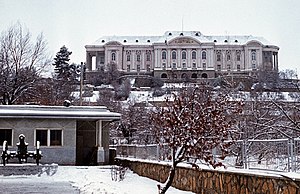
Ruins of the Queen's Palace, 2007.

Tajbeg Palace in 1987.
Tajbeg Palace or Tapa-e-Tajbeg Palace is a Palace built in the 1920s and located about ten miles (16 km) outside of the center of Kabul, Afghanistan. The stately mansion sits atop a knoll among foothills where the Afghan royal family once hunted and picnicked. It should not be confused with Darul Aman Palace, which is about 0.8 miles (1.3 km) northeast from Tajbeg.
Built to house the royal family, Tajbeg Palace is one of the most impressive landmarks of "Darulaman," newly created during the era of Amānullāh Khān by a team of European architects in an attempt to establish a new seat of government and modernize Afghanistan, both of which ultimately failed when religious conservatives forced Amānullāh from power and halted his reforms, leaving the palace in ruins as it has been for much of its existence.[1]
History[]
On December 27, 1979, the Union of Soviet Socialist Republics (USSR) launched its invasion of Afghanistan. That evening, the Soviet military launched Operation Storm-333, in which some 700 troops, including 54 KGB spetsnaz special forces troops from the Alpha Group and Zenith Group, stormed the Palace and killed President Hafizullah Amin, who resided there.
During the Soviet war in Afghanistan it served as the headquarters of the Soviet 40th Army. The palace has been severely damaged due to the quarter century of violence that has gripped the country.
The Afghan government, in conjunction with the German government, has drafted plans of renovating the palace for official use. The plan requires funds from private donations from wealthy Afghans. There are similar plans for Darul Aman Palace, which is close by, to be rebuilt and used as the building for the Parliament of Afghanistan.[2]
References[]
| Wikimedia Commons has media related to Tajbeg Palace. |
External links[]
| Wikimedia Commons has media related to Darul-Aman Palace. |
Coordinates: 34°27′17.38″N 69°6′48.04″E / 34.4548278°N 69.1133444°E
The original article can be found at Tajbeg Palace and the edit history here.